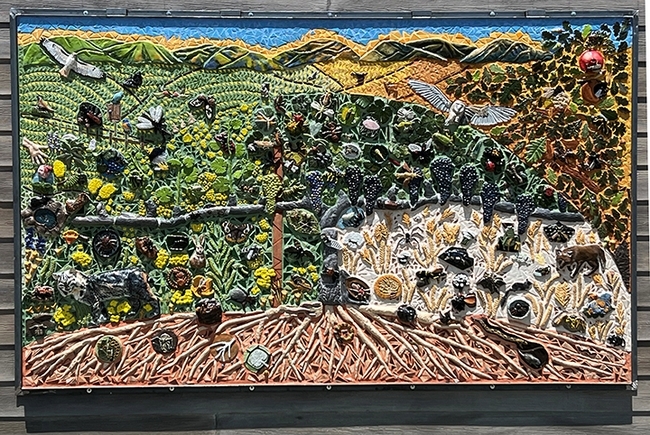
A UC Davis team created the insect-themed ceramic-mosaic mural that was recently installed at the Matthiasson Winery, 3175 Dry Creek Road, Napa.
Measuring 10 feet wide by six feet in height, it will be unveiled at an invitation-only celebration on Wednesday, Aug. 16. That's when “creators, artists, students, and volunteers will see the results of their hard, fun, and educational work creating the incredibly detailed tile mosaic mural depicting The Secret Life of Vineyards,” announced Jesse Galvan, director of hospitality for Matthiasson Wines.
The project sprang to life in a spring quarter class, Entomology 001, “Art, Science and the World of Insects,” taught by two UC Davis entomologists/artists: UC Davis Distinguished Professor Diane Ullman and assistant professor Meineke, an urban landscape entomologist.
Ullman, founding co-director of the UC Davis Art/Science Fusion Program, described the project as “a collaboration between students and instructors in ENT 001; community members from Davis, Woodland, and Napa, and Matthiasson Winery; and the UC Davis Art/Science Fusion Program. Gale Okumura (retired lecturer, UC Davis Department of Design) greatly assisted with the design and also helped train students in the ceramics technique for creating their artwork.”
In a joint statement, Ullman and Meineke related that the Secret Life of Vineyards “was designed to reflect the ecosystem within and around an organic vineyards as it progresses from early spring to harvest. A Cabernet Sauvignon vine is the centerpiece of the mural, shown from the first bud in the spring to harvest time in the autumn. The artworks include more than 80 arthropods (insects, spiders and centipedes), several bird species, mammals (bobcat, deer, rabbits, squirrels, a pocket gopher), a gopher snake, mycorrhizal fungi and even earthworms. The work is an ode to the importance of biodiversity and balance in the ecosystem in which wine vines are grown and reflects the passion of the Matthiasson Winery for sustainable viticulture.”
The directors created a PowerPoint detailing the progression of the art work and the artists' descriptions. They include such descriptions as:
Harrison Ford Spider. Nicholas Nguyen a civil engineering major, depicted the Harrison Ford spider, Calponia harrisonfordi, described by arachnologist Norman Platnick of the American Museum of Natural History in 1993. “In real life, the spider is only around 5 millimeters and much of its biology and physiology is unknown, though it's thought to eat other spiders,” Nguyen wrote. “For the design, I incorporated Indiana Jones' hat as an homage to one of Harrison Ford's most well-known roles. The hat is subdued under the roots as if a farmhand accidentally left it there after a break out of the sun or if Indy transformed into the spider of his actor's namesake.”
“C. harrisonfordi is the quintessential example of legacy,” Nguyen added. “The spider legacy of an archaeologist, blade runner, space smuggler and also environmentalist, activist, actor and ultimately hero, Harrison Ford.”
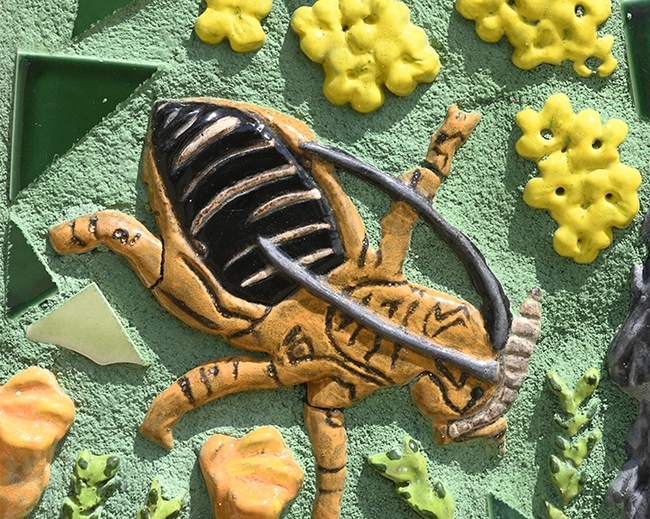
“I wanted to represent the insect scavenging for a waxworm,” Montes related. “I wanted to show that this insect appears aggressive, but also to grant visual diversity within the insect activity throughout the mural. Although many would think that the potato bug is big, clunky, and serves no purpose other than to scare people, researching the insect gave me much more insight on the importance this insect has in the environment, especially in vineyards.”
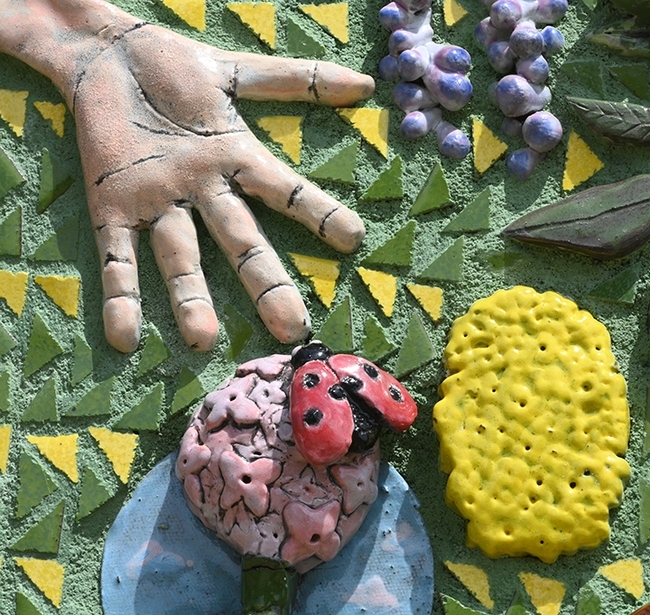
"In my design," Zhou explained, "I aimed to depict the harmonious interaction between C. californica and California buckwheat in wine yield, representing their interdependence and the beauty of their collaboration. The adjacent human is releasing the beetle to the buckwheat, representing the excellent relationship between humans and the California lady beetle. I aim to inspire people to contemplate the profound connections and interdependencies within ecosystems. The collaboration between C. california, humans, and California buckwheat serves as a reminder of the delicate balance and interconnectedness of all living beings. By celebrating the beauty of this symbiotic relationship, we can foster a deeper appreciation for nature's intricate tapestries."
Be sure to access the PowerPoint to read about all the artists' descriptions of their work. And read more about the project here.
Attached Images:
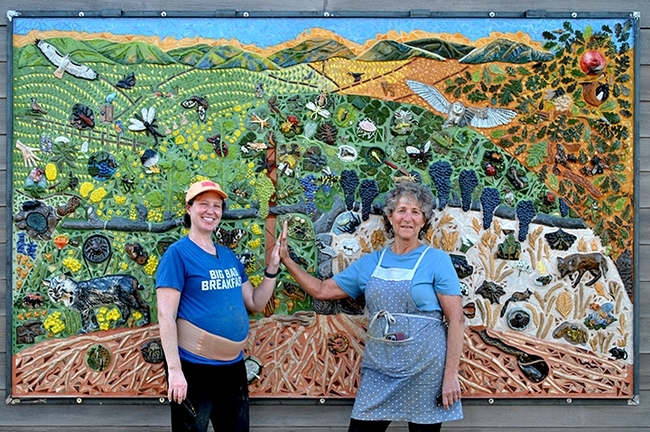
UC Davis distinguished professor Diane Ullman (right) and assistant professor and urban landscape entomologist Emily Meineke taught the class.
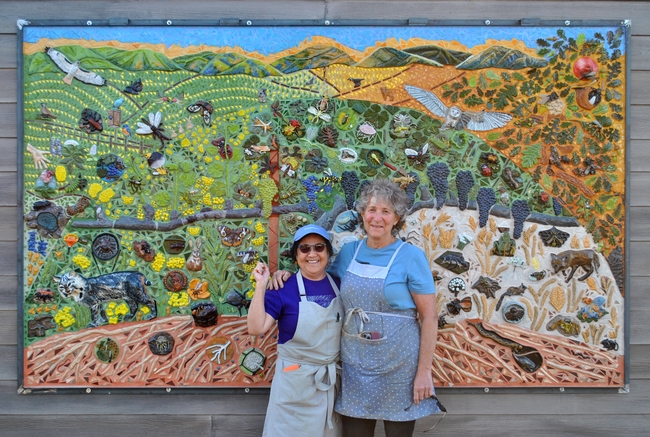
UC Davis distinguished professor Diane Ullman (right) with UC Davis retired lecturer artist/retired lecturer in the Department of Design, an integral part of the mural project.
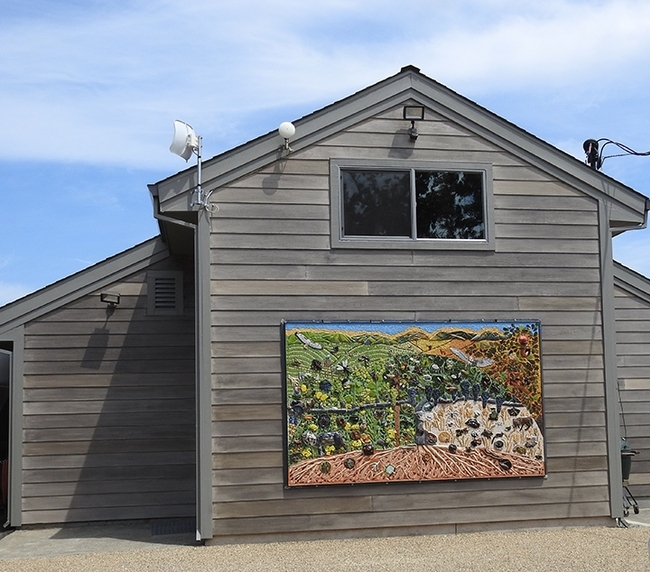
The large-scale mural is on the outer wall of the Matthiasson Winery Building and Tasting Area. (Photo by Kathy Keatley Garvey)